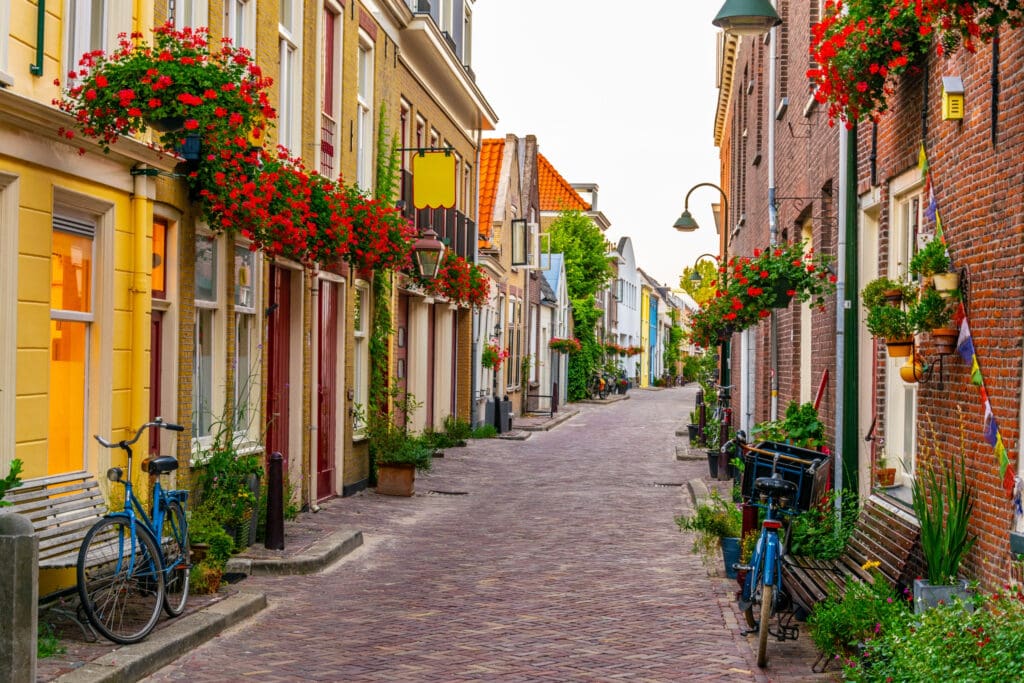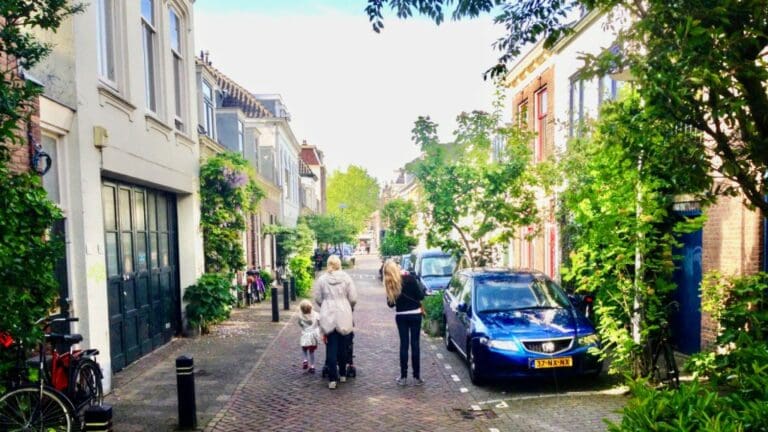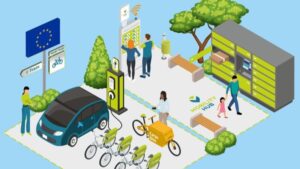Ever wonder why some streets just seem to work better than others or evoke pure joy by just walking or cycling down them? You’re not alone. Often, this feeling can be explained by our sensory interactions with simple urban planning designs in our shared spaces and roadways, such as complete streets, living streets, and the Dutch concept of “woonerfs.” Then, you might ask yourself, how can I apply these concepts to make my own street better? Well, let’s take a closer look.
There is some overlap between these three design concepts — and the terms are often used interchangeably — because the basic concept is the same: Communities must start at the basic building block of the street level and think big! What we mean by this is to take an incremental, bottom-up approach to urban design that repurposes formerly car-dominated spaces and provides for a range of uses and users.
What Are Complete Streets, Living Streets, and Woonerfs?
To better define each concept, here’s a quick rundown:
- Complete streets: Smart Growth America (SGA) defines them as “an approach to planning, designing, building, operating, and maintaining streets that enables safe access for all people who need to use them”. It tends to be more of an engineering term that focuses on the transportation aspects of a street.
- Living streets: Similar to complete streets, these are streets designed to be shared safely by pedestrians, bicycles, and low-speed motor vehicles. However, they tend to centre around the mobility of the people, not the vehicles, that frequent the street.
- Woonerfs: These are a specific type of road design that encourages multimodal transportation and blends pedestrian and vehicle space. They originated in Delft, Netherlands in the 1960s as a reaction to mid-20th century, auto-dominated urban planning. (Learn more in UMX’s free online course: Designing a Livable Neighbourhood: The Woonerf Concept.)
At its heart, all of these concepts allow people to reclaim their public spaces from the automobile and design for inclusivity, accessibility, and equity. This does not necessarily mean cars are excluded from complete and living streets. But they need to find their places amongst a range of actors.
Key elements of complete and living streets
Here’s a checklist of the design elements that are common among complete and living streets:
- Traffic rules: Pedestrians are always given the right of way, and vehicular traffic is restricted to walking speed, such as 8-15 kilometres per hour (kph) in Belgium or 20 kph in Germany.
- Traffic calming: Implementation of street features, such as road diets, speed humps, and raised intersections, that protect pedestrians and make it impossible for cars to speed up.
- Greenspace: Living streets may be landscaped with greenspace, such as trees, shrubbery, and flowers, which may also serve to calm traffic.
- Play streets: Streets that specifically give children the right to grow and play by temporarily restricting access to cars and introducing movable objects for safe play and interaction. This allows children to get exercise and socialise in front of their homes close to their family and community.
- Natural surveillance: Streets become safer because neighbors spend more time outdoors and get to know each other, which fosters a kind of natural surveillance with more “eyes on the street”, as Jane Jacobs wrote over 50 years ago.
Designing a complete and living street is easier said than done. Curious as to how other cities are designing complete and living streets? Then have a look below at some great examples!

Complete and living streets in action
It’s really an exciting time to witness the range of complete and living streets being designed and built across the globe, which has been especially noticeable since the pandemic. As a result of this once-in-a-generation urban planning shift, many people-centric design schemes were quickly and affordably implemented, such as pop-up bike lanes in Berlin.
Winnipeg, Canada (John Hirsch Place)
In 2014, the city of Winnipeg finished revamping John Hirsch Place as part of revitalisation efforts in the Exchange District, a national historic site of Canada known for its turn-of-the-century warehouses. As City Green explains, this backstreet was converted from “a one-way road with sidewalks on either side and parking spaces along the edge of the street… [to] a public open space where people could move freely from connected pathways, parking lots and buildings. Today, the new roadway hosts a new layout without the traditional curb, sidewalk and boulevard set-up, but instead, with installed bollards to guide car traffic and give residents enough protection against vehicles – allowing them to coexist safely in the city street”. Learn more about Winnipeg’s first woonerf here.
Ghent, Belgium (Car-Free and Pedestrianised)
For over 25 years, Ghent has realised the success of car-free living in its urban centre. In 1997, the city council decided to pedestrianise 35 acres of the inner city to address traffic congestion and pollution concerns. There are many lessons learned from this innovative and groundbreaking experiment in taking back public spaces and returning to the people. In a CityChangers interview with Sofie Rottiers and Hanne Geutjens from Team Leefstraten (Living Streets) at Stadt Ghent, they provide some great findings that can be applied to other cities with similar ambitions:
- People-centric planning process: Bottom-up, incremental urban planning and design, to empower the community.
- Engage all community members: Go above and beyond gathering signatures, get out into the community, and get everyone on board.
- Obtain council support: Secure political and funding support early in the project planning phase to maintain momentum.
- Manage opposition: Focus on overall social cohesion and quick wins for the entire community.
To bolster city-wide support, Living Streets Ghent was “established in which every year, between spring and autumn, residents can decide collectively to reclaim public space in the streets of Ghent”. The City of Ghent also published helpful guidance on how they implemented living streets, which you can read about here.
Bringing it all together
Designing and building a complete and active street starts with you. What was previously thought of as impossible is now taking root in cities all across the globe. Bottom-up, grassroots urban design through the use of affordable, quick-build interventions can make all the difference to take back our streets from the automobile, and thankfully we have a range of best practices to draw from.
If you want to learn more about how to design and build your complete and living street, then be sure to check out UMX’s free course Designing a Livable Neighbourhood: The Woonerf Concept which goes step-by-step with examples to show you how to create your own from scratch!

Scott Shepard
Founder & CEO @The #CitiesFirst Advisors + Podcast | Author @”#CitiesFirst: Urbanism & Mobility in the Post-COVID City” | Board @Green Mobility Magazine & Intermobility | Advisor @Urban AI | Top Urban Planning Voice





